COLLINSVILLE, Ill. — When you take a COVID-19 test, the studying actually happens at labs like Biovision Diagnostics in Collinsville.
The process starts when the specimens are collected offsite and shipped overnight to the Illinois lab.
“They make sure everything is barcoded and ready to go, and then they start processing it on our analyzers for the actual diagnosis," said Biovision CEO Vince Ojeda.
Ojeda describes his as a medium-sized lab, where they can process up to 1,000 tests a day. The lab can process tests for all kinds of medical purposes, but Ojeda says COVID-19 tests have become their main focus.
"We've had to pivot almost everything to COVID-19 at this point,” he said.
Rapid at-home tests are "antigen tests," requiring a certain amount of COVID-19 in your system to work. Labs like this run "PCR tests," or polymerase chain reaction tests. Considered the "gold standard," it means reading the sample, or "specimen," more closely.
“When we're doing the PCR testing, we are amplifying it to see if it is in there,” said Joyce McLeod, lab manager.
Think of it like a needle in a haystack, difficult to see. But if you multiply that, and have a whole handful of needles?
“You'll find at least one of them,” said McLeoud.
Whether in large processing machines or by hand, the samples are mixed carefully with certain chemicals and heated up. It's a process that makes the COVID-19 cells detectable, while "decontaminating" the samples so they are safe to handle. Then the samples are analyzed. All the work is done by highly trained lab technicians.
Each test is run with a control positive and control negative sample to make sure the process is run correctly. The control negative will show up as a flat line.
McLeod says false or inconclusive results are usually because of the way a sample was collected.
“We always now have people blow their nose prior because we're ending up with a lot of mucus on our collection devices, and that is actually not a good thing,” she said. “The mucus actually is what coats your nose to get it out. We don't want that.”
Results are then made available for the patient or provider as quickly as possible.
"We've been able to keep our turnaround time very short 24 to 48 hours from the time we get the sample into the lab,” said Ojeda.
Amid the positive and the negative of the past two years, Ojeda says labs like his have experienced hard times but will keep grinding as long as the pandemic demands it.
“There's a lot of work that goes into performing a PCR test for COVID,” said Ojeda. “It’s kind of become our world.”

